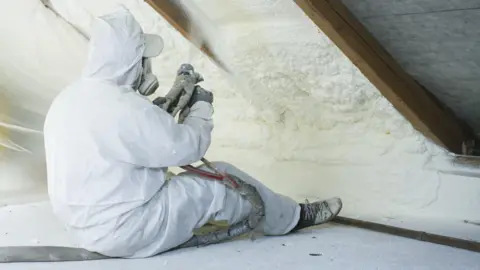
 Robbie Anderson
Robbie AndersonHomeowners say they feel “betrayed” and “conned” after struggling to sell their properties due to spray foam insulation fitted under a government scheme.
More than 160 people got in touch after BBC research found that a quarter of the UK’s biggest lenders are refusing homes where spray foam is found in the roof space.
Robbie Anderson told the BBC he felt “taken advantage of” after his house sale fell through despite having the insulation fitted under the previous government’s Green Homes Grant scheme.
Liberal Democrat MP Tom Gordon has written to the energy secretary calling for “decisive action”, while the Department for Housing has said it is consulting with lenders.
Estimates suggest as many as 250,000 homes in the UK have this type of insulation, with much of it installed under the previous government’s official scheme.
The Green Homes Grant scheme, which ran in England, saw installations completely subsidised for those on certain benefits.
But some of the UK’s biggest mortgage firms are reluctant to deal with homes with spray foam insulation due to concerns over poor fittings leaving moisture trapped and roof timbers at risk of decay.
Industry experts have told the BBC spray foam is an effective insulator if fitted properly, and urgent action is needed to stop panicked homeowners needlessly turning to “cowboy” removal companies.
Robbie, 38, had spray foam fitted in 2021 with the entire £5,733 cost covered by the Green Homes Grant scheme because he was eligible for certain benefits at the time.
He and his wife hoped to move to a bigger house in Nottingham, closer to potential secondary schools for their young daughter.
When they put their house on the market this summer, they quickly received an offer at asking price. But Robbie said he was “shocked” when the buyers’ lenders rejected the property and they pulled out of the purchase.
 Getty Images
Getty ImagesThe work was carried out by a Trustmark-approved installer and Robbie was given documentation including a British Board of Agreement (BBA) product certificate.
But the prospective buyers’ mortgage provider said it needed an insurance-backed installation warranty with a minimum of 10 years, despite Robbie having one with the industry standard of two years.
He told the BBC he felt a “little bit betrayed” and confused over what to do next, with 12 months remaining on their current mortgage.
The couple are planning to remove the insulation themselves, having been quoted £4,000.
“I don’t feel it’s fair that we should have to pay to get this removed,” Robbie said.
“[The government] have to take accountability for it… given that they forked out for something they thought was a good thing.”
What is spray foam insulation?
Spray foam insulation has been used to stop heat escaping from roofs, lofts and attics for decades and comes in two forms.
Closed cell spray foam is rigid once set. It is a better thermal insulator and was previously sold to stabilise failing roofs. But if it has been used inappropriately or installed poorly, it might put stress on timbers, restrict air circulation and put them at risk of decaying.
Open cell spray foam remains soft once set and is only used for insulation. It is more breathable but is often installed where a highly-resistant underlay like bitumen felt is already present, stopping vapour from escaping.
Geoff Hunt, an independent chartered building surveyor, said open cell spray foam had gained popularity in recent years, bolstered by government initiatives.
But he said mortgage lenders struggle to assess spray foam, leading to “caution and refusals on higher-risk applications”, for example, where it has been applied directly onto roof tiles.
Properly-installed open cell foam on a sound roof has not been conclusively linked to roof decay, he added, emphasising that it is important for homeowners with this type of insulation not to panic.
‘Conned’
Philippa from Wiltshire also had open cell spray foam fitted in her loft in 2021, with the £8,662 cost covered by the Green Homes Grant scheme.
She recently accepted an offer from first-time buyers on her property, but said Nationwide would not lend to them without further paperwork on the insulation.
She said this “spooked” her buyers and they pulled out before she had the chance to supply the additional documents.
Nationwide told the BBC it was “unable to make a final lending decision” without documentary evidence that spray foam was installed correctly or a report on the structural integrity of the roof.
Philippa said she cannot afford to remove the insulation and has reduced her asking price to cover the cost on any future buyer’s side.
“I feel like I’ve been conned by the government,” she said, adding that she did not believe spray foam insulation should be available for sale until there is a better understanding of the product.
‘Un-mortgageable’
While the Green Homes Grant scheme closed in 2021, spray foam insulation is still available under the Great British Insulation Scheme as the government seeks to improve the energy efficiency of homes and drives towards its 2030 “net zero” target.
Rico Wojtulewicz, head of policy at the National Federation of Builders, said he had been trying to raise awareness of potential issues with spray foam insulation for years.
“Government may view spray foam as an easy solution but an un-mortgageable, unhealthy or damaged home is a worse outcome than requiring greater retrofitting thought or more expensive heating,” he said.
He is calling for the government to work with installation companies.
It comes as Liberal Democrat MP Tom Gordon has written to Energy Secretary Ed Miliband, calling for “decisive action” and “support” for homeowners facing financial repercussions.
Mr Gordon said he was moved to act after he and many of his party’s MPs had been contacted by constituents facing unexpected costs, the letter said.
“This government must do more to support them,” it added.
The Department for Housing told the BBC it had “consulted lenders” on spray foam insulation, and it would “rely on the views of valuers and surveyors on this issue”.
It said any measures fitted under government schemes must be done by a Trustmark-registered installer and to the highest standards, with any issues fixed promptly.

Advice for homeowners
For homes where spray foam insulation is already present, the Homeowners’ Alliance recommends:
- Checking you have all the relevant documentation, including a product certificate, installer warranty, before and after photos, a survey report and a product warranty
- Contacting the installer or manufacturer to see if you can get a free “health check”
- Considering an independent assessment by a qualified spray foam surveyor
Currently, it does not recommend installing spray foam until issues with lenders and rogue traders are resolved.



Be the first to comment